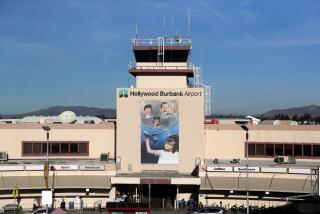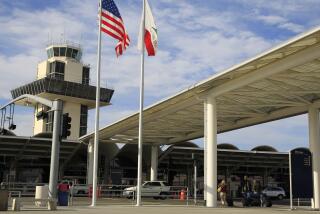Pittsburgh Finds No Takers for Its Old Airport Terminal : Real estate: Parcel facility, aviation museum and movie houses ruled out for spider-shaped building.
- Share via
PITTSBURGH — When Pittsburgh’s steel mills were running full tilt, giving the city its famed multicolor sunsets, the airport was its pride and joy. But, as the mills went, so will go this piece of the city’s history.
It measures 750,000-square feet and once was a center of travel here, but now Pittsburgh’s old airport is looking more like a monstrous white elephant, officials say.
The building sits alone on a plot of land like a giant steel-and-concrete spider, with legs jutting out from its center belly. It’s virtually empty.
The old airport first operated as a military airport in World War II and opened for commercial traffic in the 1950s. But Pittsburgh opened a sprawling new airport three years ago, leaving the city in a quandary over what to do with the old one.
There have been any number of proposals since the old airport was closed in 1992, but no money to back them up.
The Allegheny County Department of Aviation first proposed an office park, but could not find investors. Then the Smithsonian Institution proposed turning the airport into a museum annex that would house a civil aviation museum.
But the Washington-based national museum said it would provide artifacts for the site only if Allegheny County agreed to build additions that Pat Boyle, deputy director of the aviation department at the new Pittsburgh International Airport, said could have cost up to $100 million, so the Smithsonian built the annex in Washington.
A Pittsburgh real estate firm, National Development Co., proposed turning the airport into an entertainment complex that would house Broadway-style theaters and retail shops. But again, there were no investors.
The U.S. Postal Service and Roadway Package Systems, the Pittsburgh-based subsidiary of the trucking firm Roadway Services Inc., considered using the airport as a facility for postal and trucking operations.
“We also had movie companies in there who were looking at building cinemas,” Boyle said. “But it’s a specialty building. It’s a steel spine building with a lot of curved, narrow passageways, and it didn’t suit any of their needs.”
Currently, Grubb & Ellis Co., the San Francisco-based real estate firm, has been scouring the nation for investors that may have the capital and interest to revamp the giant building.
But as months have passed since it closed, it has looked more and more like the building will be demolished, going the way of the aged, rusting steel mills the city has been tearing down.
“The bottom line is, we’ve heard a lot of ideas, but there haven’t been any funds to make them happen,” Boyle said. “Now we’re looking at tearing it down.”
Boyle said it would cost millions to demolish the old building, mostly due to environmental costs. The airport is full of asbestos and lead-based paint, and oil has seeped into the ground over the years.
“The city recognized it needed a new airport. We would have lost the USAir hub had we not built it,” Boyle said. “The old airport was just too old, and too small.”
USAir is among Pittsburgh’s largest employers, with 11,000 workers in and around the city. The airline controls about 90% of the flights through the new airport, which covers 2 million square feet and sits just a couple of miles from the old one.
In the end, Boyle said, the site of the historic old building might prove most valuable as an empty piece of land. “Real estate interests have told us it’s a marketable piece of land, and we may be better off just demolishing the airport and selling the land,” he said.
More to Read
Inside the business of entertainment
The Wide Shot brings you news, analysis and insights on everything from streaming wars to production — and what it all means for the future.
You may occasionally receive promotional content from the Los Angeles Times.










